It’s the iteration of hypothesis, changes, and measurement that will make you better at a faster rate than anything else we have seen.
We’ve heard this and similar quotes in the context of product development repeated over and over during the last decade. In younger startups business=product and hence agile development meant agile business.
When it comes to larger businesses we’ve been developing, using, and honing several methodologies over the last several decades to bring focus and alignment among a committed workforce to design, measure, and operate business processes that enhance customer experience and grow the business.
The Optimization Waves
In the context of larger businesses, there has been a shift from traditional to modern, faster, optimized ways of doing business at three levels:
- Transaction Optimization
- Engineering Optimization
- Business Optimization
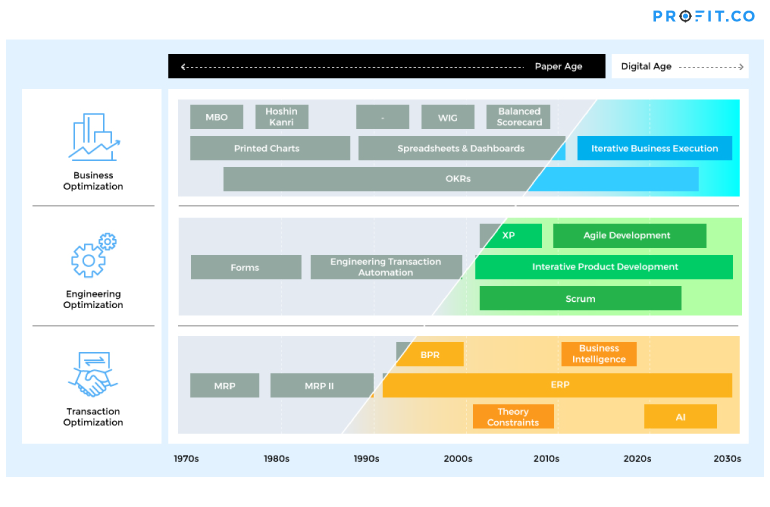
The Transaction Optimization Wave
Transaction optimization primarily focused on automating business transactions like receiving materials into inventory, automating financial accounting, bookkeeping, and automating manufacturing execution, among many other business processes and transactions that happen within a business to research, make, store, sell, collect and produce financial reports for a business. Manufacturing planning and inventory tracking were getting automated since the beginning of the 70’s, but the real wave started when the term “ERP” came into the picture during the 90’s. ERP included not just manufacturing, but all aspects of the business.
ERP stayed on since then, but more as a mothership than as the “only” system. Along with the advent of ERP, the concept of business process reengineering also emerged in a big way. Typical outcome of a BPR exercise was an improved business process that is well supported by an amazing software system. And in many cases, this amazing software system happened to be the ERP system itself.
Once this wave started, there were several add ons to the ERP mothership — Human Resource Management, Advanced Planning or Constraint-Based Planning, Customer Relationship Management, Business Intelligence, and recently a flurry of AI initiatives to make transactions even more optimized. Eliminating/reducing waste in all forms is the theme of this wave.
So that’s the first wave of transaction optimization. Obviously it’s still going, but the shift actually started occurring somewhere in the mid-80s. When ERP started becoming mainstream.
The Engineering Optimization Wave
We did have engineering automation as part of the previous wave, which were primarily focused on automating engineering transactions such as new product authorizations, engineering change orders, issue tracking or bug tracking, and many such transactions.
The shift from transactions to optimizing product development started in the early 2000s when movements such as agile product development, extreme programming, scrum and others started coming up. These movements predominantly focused on technology companies and startups.
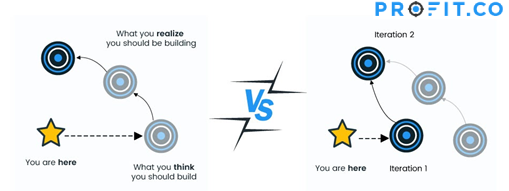
Thus started this iterative product development wave which is still going. The methodologies have flourished during this phase. But, the most dominant methodology has been scrum, which has now evolved into SAFe. Enterprises have been using the scrum approach to get products developed in an iterative way to get faster time to market with good quality, and minimized risk. You get prompt, faster feedback, make quick adjustments to your features, schedules and get to your ideal product position sooner, so you can scale faster.
The Business Optimization Wave
Business management methodologies have been around for many decades. We’ve had:
- MBOs in the 60’s
- Hoshin Kanri in the 70’s, although predominantly practiced by Japanese companies
- OKRs since the 70’s, although practiced by very few companies till the early 2000
- WIG, or wildly important goals since the 90’s.
- Balanced Scorecard since the 90’s
But, none of them hit the mainstream till 2000. When companies like Google and a few others started using OKRs from the early 2000s, the concept of OKRs started evolving into a complete “management system” that incorporated “best practices” learned by OKR practitioners and borrowed from other successful methodologies.
Around this time, a few large companies also started creating their own versions of iterative management methodologies. For example, Salesforce.com’s Marc Benioff launched a methodology called V2MOM. In Benioff’s own words:
- Vision helped us define what we wanted to do.
- Values established what was most important about that vision; it set the principles and beliefs that guided it (in priority).
- Methods illustrated how we would get the job done by outlining the actions and the steps that everyone needed to take.
- Obstacles identified the challenges, problems, and issues we would have to overcome to achieve our vision.
- Measures specified the actual result we aimed to achieve; often this was defined as a numerical outcome.
Business optimization, as a mainstream movement started in the mid 2010’s. While there were many competing methodologies, OKRs had the broadest adoption because several successful companies had adopted OKRs, and hence there were a lot of awareness, supported by a comparatively large number of OKR practitioners/coaches. The other main reason for adoption was the availability of many software solutions which helped adopting OKRs easier and also provided a way to connect the OKR Process to other aspects of the business.
The digitization of the OKR process and the integration of OKRs into the other key aspects of a business is a huge reason for the uptick in OKR adoption as the primary approach to iteratively manage a business. You can certainly start an OKR journey or a WIG journey using spreadsheets and powerpoints. When it comes to scaling OKRs, you’ll feel the same pain felt by businesses that were using standalone, non-scalable software in the 80’s which pushed them to move towards holistic ERP solutions.
When it comes to iteratively executing your business, it’s important to:
- Focus on the right initiatives
- Ensure everyone involved is Aligned with the key focus areas established.
- Ensure that you have a Committed team behind you.
- Establish clear Tracking metrics and schedules.
- Promote an aggressive culture by pushing your teams to Stretch and not treat every initiative as business as usual.
Over the years the “system of OKRs” has evolved into a holistic approach that supports all the 5 benefits of an proper iterative business execution methodology. You create aspirational OKRs to iteratively execute your key business priorities, while creating committed OKRs to keep the business as usual aspects of your business running.
Engineering Optimization Vs. Business Optimization
While the Engineering Optimization and Business Optimization waves were different, there are several similarities. Let’s quickly understand the similarities between scrum and OKRs, each of which are the most popular approaches in their respective waves.
| Scrum | OKRs | |
|---|---|---|
| Cycle | Sprint | Quarter |
| Typical Cycle Duration | 2 Weeks | Quarter |
| Planning Process | Sprint Planning | OKR Planning |
| Planned Work | Spring Backlog | Quarterly OKRs |
| Review Process | Daily Standup | Check Ins + Weekly group review |
| Review Cycle | Daily | Weekly |
| End of Cycle Review | Sprint Retrospective | OKR Reflect/Reset |
Cycle & Duration
In Scrum, we call a cycle as a Sprint and the duration of a sprint is usually 2 weeks. In OKRs the cycle is usually a quarter and duration is called a quarter as well.
Planning Process
In Scrum, you conduct a sprint planning process where you go through all the “candidate features” to build, which is called a “product backlog” and decide what can be accomplished in the sprint. This planned work is called the “sprint backlog.”
In the case of OKRs you have an OKR planning process where you actually go through:
- What is remaining from the last quarter’s plan, that is still relevant.
- What new key results need to be added to the plan.
And prepare the plan. This list is called the quarterly OKRs.
Review Process
The review process in scrum is called the “daily standup” and then the cycle is basically daily.
In OKRs, we call the OKR review as check-ins and it is typically weekly, and sometimes once in two weeks. Check-ins are supplemented by weekly group reviews to understand the progress made during the previous week, plan for the upcoming week and anticipated problems in executing that plan.
End of Cycle Review
The end of cycle review is called Sprint Retrospective in the scrum methodology. The Sprint Retrospective is an opportunity for the Scrum Team to inspect itself and create a plan for improvements to be enacted during the next Sprint. The Sprint Retrospective occurs after the Sprint Review and prior to the next Sprint Planning.
In OKRs the end of cycle review is called OKR Reflect/Reset. You establish a structured process to reflect on what happened in the quarter, documenting and sharing learnings. You then go back to the drawing board and prepare the plan for the next quarter considering your business plan and the collective learning from executing the OKRs of the previous quarters.
Iterative Business Execution
As we saw earlier, there are several similarities between popular methodologies in both waves, at the conceptual level. But there are several differences between the two groups of methodologies at the operational level. Documenting these differences is beyond the scope of this article, so we’ll focus on implementing an iterative business execution process using OKRs.
A holistic system for iterative business execution.
How can we visualize and implement iterative business execution in your business. Following are the key components of iterative business execution:
- Strategy
- OKRs
- Tasks
- Employee Engagement
- Employee Development
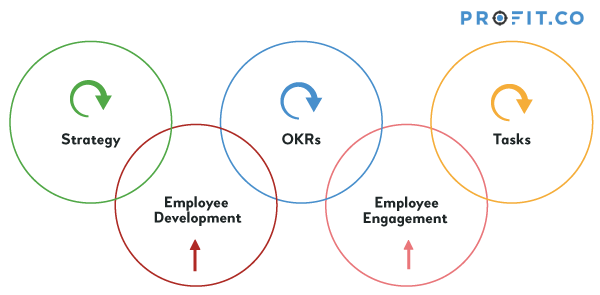
Strategy
You start with the Vision & Mission of your enterprise. This should provide the common purpose to rally your employees to pursue your organizational goals with vigor. There are several strategy process deliverables that need to be prepared to ensure you have a clear strategy for your business. The list includes the following:
- Establish strategic priorities
- Decide the focus areas or strategic perspectives
- Design initiatives with milestones within these focus areas, to achieve the strategic priorities
- Identify strategic KPIs that need to be tracked to measure strategy progress
Your strategic exercise plans for anywhere between 3 to 5 years. And then you conduct strategic reviews and audits to measure progress and make adjustments.
OKRs
You take that strategic direction and create OKRs — objectives and key results. OKRs provide an execution roadmap for your strategies and help you track, report, and adjust your execution plan on a quarterly basis. So do you go about creating and managing using OKRs.
Anchor your Objectives
When you begin your quarter, you need to know what your key objectives are and ensure that your senior leadership clearly and consistently understands what these objectives are.
Plan your outcomes for each of these Objectives
In order to unequivocally claim that you have reached your anchored objectives, what would you like to see as tangible results. They would be your planned outcomes or planned key results.
An approach to planning your outcomes is to imagine yourself time traveling to the end of the quarter in question, and visualizing what you would like to see as key results. Now, this cannot be a complete dream. It has to be aggressive, but achievable.
Cascade down & up, to establish OKRs at different levels of your business
Create OKRs for subsequent levels in your business and ensure that employees at every level is clear on what they need to accomplish and how they impact the OKRs of their managers and finally the company’s OKRs.
Weekly Check Ins
Weekly check-ins allow you:
- To get a pulse check on what is happening with your group’s OKRs
- Feed off of each other’s successes and get the desired outcome at the end of the quarter.
- Share your learnings with others and promote collective problem solving
- Resolve bottlenecks with dependencies
Business optimization, not department optimization
So at this point we talk about business optimization, not department optimization. So it’s really important to optimize for the success of the business, not to make a particular department look good. OKR planning and execution need to provide direction for every employee, but flexible enough to accommodate changes due to business priorities.
Tasks
Tasks are the engines of daily work. We refer to tasks here loosely. They could be activities in your CRM system that you perform as part of your outreach or working on customer reported issues in your complaint tracking system. But these are the “daily management” vehicles that help you achieve the key results that were planned as part of your OKRs.
Employee Engagement
Employee engagement is the key ingredient for successful iterations of your business priorities. Total employee involvement needs to be promoted by:
- Acknowledging and recognizing achievements
- Promoting learning & sharing
Engagement doesn’t happen automatically. There has to be a conscious effort by the organization to promote engagement. There is no single magic trick here. A collective system needs to be designed and implemented to promote engagement.
Employee Development
Understanding the developmental needs of employees through conversation and feedback sessions is the final component. Again, while high-performance organizations rely on employees’ initiatives to build their capabilities needed to perform their work, you need to have a process for identifying required skills, understanding your current capabilities and skills gaps, and find innovative ways to fill this gap, all the way from training current employees to hiring experts in that field.
This component is different from the others. It generally is focused on individuals, how they performed in the past periods and how they fit in the future plan.
Habitualize Iterative Business Execution
Institutionalizing and habitualizing iterative business execution is key to reap the benefits of iterative business execution. There are a lot of moving parts. And there are a lot of moving parts within those moving parts.
This is where complexity sets in. Not paying attention to this complexity can harm your business. If you thought you could write your OKRs religiously and then revisit them at the end of that quarter to understand what you have done, you are in for a shock. But it shouldn’t surprise you, if you are reading this. Business iterations require several components to be in place. If you have 2 out of the 10s of components in place and expect to achieve the results that are achieved by perfect systems, you can be 100% sure that you will not get it.
So, is there a standard template for an iterative business execution system? No. That doesn’t exist. Every business is unique. Your iterative execution system will also be unique. The good news is that you can design your own system that will work for you and can also be a competitive advantage for you. The “not so good news” is that it will take a few iterations and some time. You won’t have your perfect system in place on day one. In 2-3 quarters you will start seeing the system coming together.
It’s very important to have a structured, repeatable process, which becomes a habit in your organization. Both the concept and process of your own iterative business execution system needs to be a part of your organizational DNA. New employees should be able to insert themselves into your iterative business execution process without much of a struggle.
Why Iterative Business Execution is gaining steam?
There are a few key trends that have resulted in current wave of “Iterative Business Execution”. Four factors have created the ideal conditions for the “Iterative Business Execution” tidal wave. These trends feed into each other and add to a much larger whole.
Business Processes go Digital:
As broadband and mobile internet penetration at home and work crossed critical thresholds in the first years of the 21st century, key business processes started moving to digital.
Digital marketing has captured a large share of the advertising dollars (still growing) with ability to precisely target the desired set of customers and make rapid changes to the marketing messages based on instant feedback.
Sales, both in B2C and B2B is going digital and gaining steam. From books to diamonds and from office supplies to multi-million dollar machinery, both consumers and businesses are embracing online sales at a furious pace. Digital technologies help companies to constantly improve customer-facing processes to remove friction, improve engagement, boost conversions and increase online sales.
Procurement was one of the earliest business processes to go digital with establishment of B2B marketplaces and digitization of supply chains. This resulted in increased transparency and visibility across the entire chain.
HR has embraced digital for all key processes including hiring, onboarding, training, employee engagement and performance management
Cloud Computing, the great leveler:
Cheap storage, processing power and ubiquitous connectivity have accelerated businesses moving to the cloud. This has helped teams to rapidly develop new customer-facing applications and quickly deploy them and test for better customer acceptance and usage.
Till the 90s business and IT used to have an arms-length relationship. Business typically had a long wait time to get IT’s attention to develop new applications or enhance existing ones to meet their requirements.
Two things have changed in this century. Increasingly the business workforce is dominated by digital natives who grew up with computers and the internet and are quite comfortable experimenting with cloud applications for their needs, overriding IT if required.
Speed:
The pace of doing business has dramatically increased. Probably the best way to indicate this is through this chart – the time taken for 50 million users to adopt a product/technology
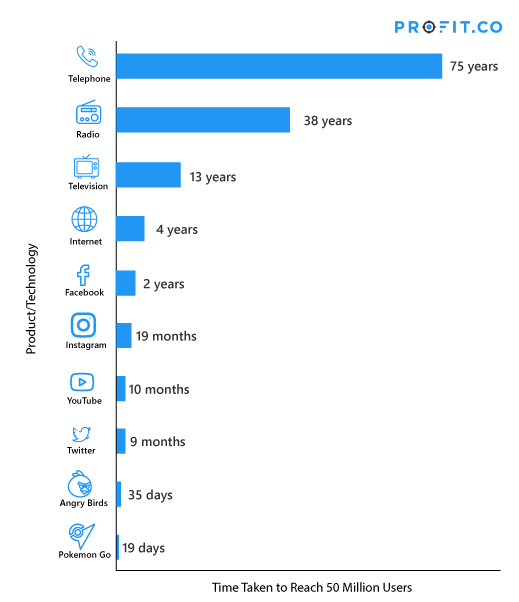
Data based Decision making:
The TV show Madmen showed how advertising decisions were made during the 60s, the golden age of mass media advertising. High powered Cigar smoking Advertising executives made the decision on multi-million dollar campaigns through their “hunches”. Gone are those days – Today, decision making has decisively shifted to “ Data-based instead of Intuition based“.
Successful companies like Apple, Amazon, Google, Booking.com and Expedia conduct thousands of experiments at any given time and make their decisions based on data rather than hunches and guesses.
A/B Testing is extensively used to test, Pricing, user adoption, Content and all aspects of sales marketing, sales and customer adoption.
Adopting Iterative Business Execution is not for Apple, Amazon and Google alone, anymore
If you think that Iterative Business Execution is only for technology giants like Apple, Amazon and Google alone, think again. They became such behemoths because of “Iterative Business Execution”. Today every industry is being disrupted by companies that have embraced Iterative Business Execution.
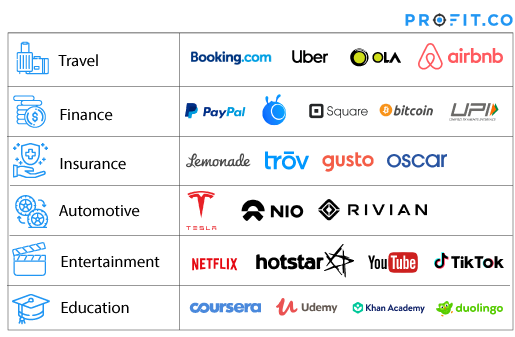
These companies designed their business models from scratch using technology and processes to embrace Iterative Business Execution. For companies that wish to serve the digital natives and maintain their industry leadership, the choice is clear – Adopt Iterative Business execution or go the way of Fax machines and typewriters.

